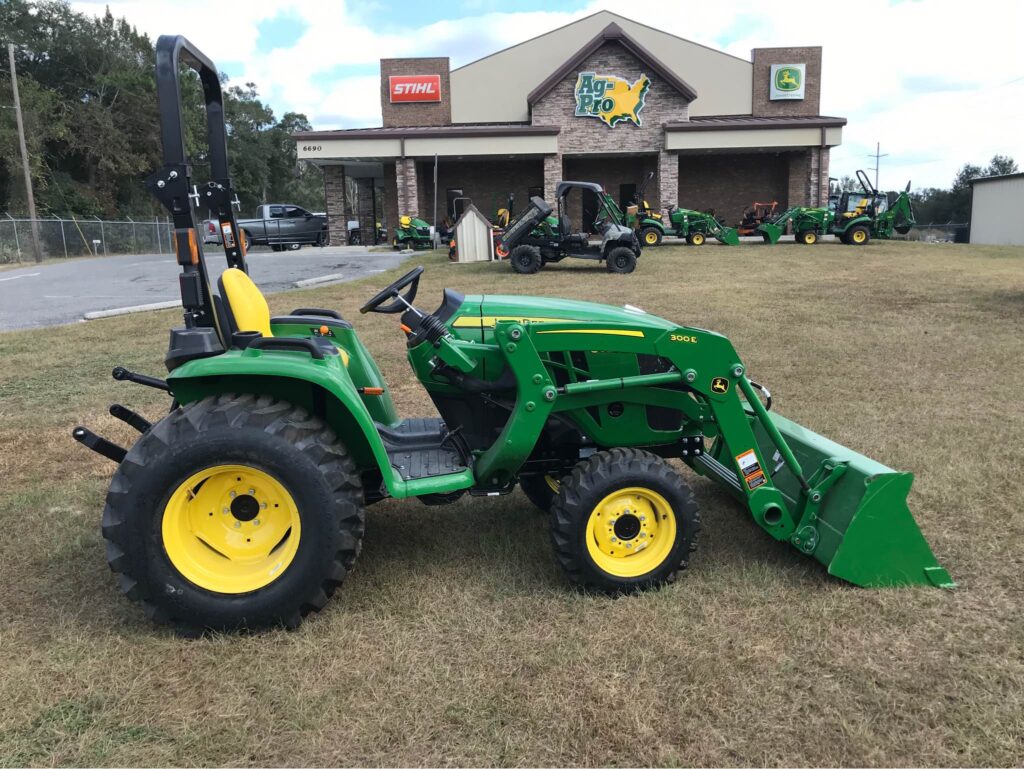Imagine cutting your lawn care time in half while enjoying a smooth, effortless ride. Sounds appealing, right? Did you know that John Deere, a name synonymous with quality and reliability, sells over 2 million lawn tractors annually? With lawn maintenance being a vital task, choosing the right tractor is crucial for efficiency.
John Deere offers a range of lawn tractors tailored to your specific needs. Whether you have a small yard, uneven terrain, or a tight budget, their 100, 200, and 300 series have you covered. In this post, we’ll dive deep into these series to help you find the perfect fit for your lawn care needs.
Keynote: John Deere 100 vs 200 vs 300 Series
The 100 Series is perfect for small yards, offering affordability and maneuverability. The 200 Series balances power and versatility for medium-sized lawns. The 300 Series delivers superior power and durability, ideal for large properties. Choose based on yard size, terrain, and budget.
John Deere 100 Series
The John Deere 100 Series is designed for homeowners with small yards. Its compact and lightweight design makes it easy to maneuver and store, perfect for tight spaces and simpler tasks.
Key Features
- Engine Specifications: The 100 Series offers engines with various power outputs, typically ranging from 17.5 to 25 horsepower. These engines provide sufficient power for regular mowing tasks.
- Cutting Width and Deck Size: The cutting widths range from 42 to 54 inches, allowing for efficient mowing of small to medium-sized lawns.
- Transmission Types: The 100 Series includes models with both manual and automatic transmissions, catering to different user preferences.
Pros and Cons
Pros:
- Affordability: The 100 Series is budget-friendly, making it accessible to a wide range of homeowners.
- Maneuverability: Its lightweight design ensures easy handling and maneuvering, even in tight spaces.
Cons:
- Power Limitations: While suitable for small yards, the 100 Series may lack the power needed for larger properties or tougher terrains.
- Cutting Capacity: The smaller cutting deck sizes may require more passes to cover larger areas, increasing mowing time.
John Deere 200 Series
The John Deere 200 Series is ideal for homeowners with medium-sized yards. This series strikes a balance between power and maneuverability, making it suitable for more demanding lawn care tasks.
Key Features
- Engine Specifications: The 200 Series features engines with power outputs typically ranging from 19 to 24 horsepower. These engines provide enhanced performance for a variety of mowing and yard maintenance activities.
- Cutting Width and Deck Size: The cutting widths in this series range from 42 to 54 inches, offering efficient coverage for medium-sized lawns.
- Transmission Types: Models in the 200 Series are equipped with either manual or hydrostatic transmissions, allowing for smoother operation and greater control.
Pros and Cons
Pros:
- Increased Power and Cutting Capacity: The 200 Series boasts more powerful engines and larger cutting decks, reducing mowing time and handling tougher grass.
- Versatility: This series supports a wide range of attachments and implements, enhancing its functionality for various yard tasks beyond just mowing.
Cons:
- Higher Price Point: The advanced features and increased power come at a higher cost, making the 200 Series a larger investment compared to the 100 Series.
John Deere 300 Series
The John Deere 300 Series is designed for homeowners with large yards or small acreages. Known for its powerful and heavy-duty construction, this series is built to handle extensive and demanding lawn care tasks.
Key Features
- Engine Specifications: The 300 Series features robust engines with power outputs typically ranging from 22 to 25 horsepower. These engines are designed to provide superior performance and endurance.
- Cutting Width and Deck Size: The cutting widths in this series range from 48 to 60 inches, allowing for efficient mowing of large areas in less time.
- Transmission Types: Models in the 300 Series come with hydrostatic and all-wheel drive transmissions, offering seamless operation and enhanced traction on various terrains.
Pros and Cons
Pros:
- Superior Power and Cutting Capacity: The 300 Series excels in power and efficiency, making it ideal for large properties and tough mowing conditions.
- Durability and Longevity: Built with heavy-duty materials and components, the 300 Series ensures long-lasting performance and reliability.
Cons:
- Higher Price Point: The advanced capabilities and durable construction result in a higher price tag, requiring a significant investment.
- Larger Size: The increased size of the 300 Series can make it less maneuverable in tight spaces, potentially limiting its usability in smaller yards.
Comparison Table
| Feature | John Deere 100 Series | John Deere 200 Series | John Deere 300 Series |
|---|---|---|---|
| Engine Power | 17.5 – 25 HP | 19 – 24 HP | 22 – 25 HP |
| Cutting Width | 42 – 54 inches | 42 – 54 inches | 48 – 60 inches |
| Transmission Types | Manual, Automatic | Manual, Hydrostatic | Hydrostatic, All-Wheel Drive |
| Price Range | $1,800 – $2,800 | $2,800 – $4,000 | $4,000 – $6,000 |
Factors to Consider When Choosing a Series
Yard Size and Terrain
When selecting a John Deere lawn tractor, consider your yard size and terrain. For small, flat yards, the 100 Series offers sufficient power and maneuverability. Medium-sized yards with varied terrain benefit from the 200 Series, which balances power and ease of use.
Large properties or small acreages with complex terrains are best suited for the robust 300 Series, offering superior power and traction.
Desired Cutting Performance
Your lawn’s cutting requirements dictate the necessary cutting performance. The 100 Series handles basic mowing tasks efficiently, while the 200 Series provides enhanced cutting capacity for medium-sized lawns. For extensive and demanding mowing needs, the 300 Series delivers superior performance with its wider cutting decks and powerful engines.
Budget
Assessing your budget is crucial. The 100 Series is the most affordable, making it ideal for cost-conscious buyers. The 200 Series, while more expensive, offers greater versatility and power, justifying the higher price for more demanding tasks.
The 300 Series, with its high-end features and durability, requires a significant investment but offers long-term value for extensive lawn care needs.
Attachments and Implements
Compatibility with attachments and implements enhances the versatility of your lawn tractor.
The 100 Series supports basic attachments, making it suitable for standard mowing. The 200 Series allows for a broader range of attachments, including snow blowers and baggers, enhancing its functionality. The 300 Series is the most versatile, supporting heavy-duty attachments like tillers and front-end loaders.
According to John Deere, “The 300 Series supports over 40 different attachments, making it the most versatile in its class.” This extensive compatibility ensures that you can tackle various yard tasks with ease, maximizing your investment.
Maintenance and Ownership Costs
Initial Purchase Price
When evaluating the initial purchase price, the John Deere 100 Series is the most budget-friendly option, with prices ranging from $1,800 to $2,800. The 200 Series falls in the mid-range category, with costs between $2,800 and $4,000. The 300 Series, being the most advanced and powerful, is the most expensive, with prices ranging from $4,000 to $6,000.
Fuel Efficiency
Fuel efficiency varies across the series:
- 100 Series: Known for its fuel economy, consuming approximately 0.5 to 0.7 gallons per hour.
- 200 Series: Slightly higher fuel consumption due to increased power, averaging 0.7 to 0.9 gallons per hour.
- 300 Series: Highest fuel consumption, typically around 0.9 to 1.1 gallons per hour, reflecting its powerful engine and larger size.
Service and Repair Costs
Maintenance and repair costs also differ by series:
- 100 Series: Generally low maintenance costs, with annual servicing averaging $100 to $200.
- 200 Series: Moderate costs, with annual servicing around $200 to $300. Repairs may be slightly higher due to more complex components.
- 300 Series: Higher maintenance and repair costs, with annual servicing typically between $300 and $500. However, its durability often means fewer repairs over time.
Replacement Parts Availability
Replacement parts for John Deere tractors are widely accessible:
- 100 Series: Parts are readily available and relatively inexpensive.
- 200 Series: Parts are also easy to find, with costs slightly higher than the 100 Series due to more advanced components.
- 300 Series: Parts are available but can be more expensive. The advanced and specialized nature of the 300 Series components contributes to higher replacement part costs.
John Deere ensures extensive parts availability across all series, with a vast network of dealers and online resources, ensuring that you can maintain your tractor efficiently and effectively.
Final Thought
Choosing between the John Deere 100, 200, and 300 Series ultimately depends on your individual needs and preferences. Whether you prioritize budget, power, or versatility, there’s a model designed to meet your specific requirements. Each series offers unique advantages, from the affordability and maneuverability of the 100 Series to the superior power and durability of the 300 Series.
Consider what matters most to you in a lawn tractor. Think about your yard size, terrain, and the tasks you’ll be tackling. Your choice is not just a purchase but an investment in the ease and efficiency of your lawn care routine. As you make your decision, remember that the right tractor can transform your lawn maintenance experience, making it not just a chore but a pleasure.
Comparison of John Deere Lawn Tractors (FAQs)
What is the most reliable John Deere series?
The John Deere 300 Series is often regarded as the most reliable. Its powerful engines and durable build ensure long-lasting performance.
How many hours will a John Deere X300 last?
A John Deere X300 can last over 600 to 1000 hours with proper maintenance. This longevity makes it a reliable choice for homeowners.
How much weight can a John Deere 100 pull?
The John Deere 100 Series can pull up to 500 pounds. This capacity is sufficient for light-duty towing tasks.
Does the X300 have power steering?
Yes, the John Deere X300 has power steering. This feature enhances maneuverability and ease of use.
What makes John Deere so expensive?
John Deere is expensive due to its high-quality materials, advanced technology, and reliable performance. The brand’s strong reputation also adds to its value.
Which is better, a Craftsman or a John Deere riding mower?
John Deere riding mowers are generally considered better for durability and performance. Craftsman mowers are often more affordable, offering good value for budget-conscious buyers.
What is the warranty period for John Deere Signature Series mowers?
The warranty period for John Deere Signature Series mowers is typically 4 years or 500 hours, whichever comes first.
What hp range do John Deere Select Series lawn tractors offer?
John Deere Select Series lawn tractors offer an hp range from 21 to 25, providing robust performance for various tasks.
What is the key feature of the mower deck in John Deere series mowers?
The mower deck in John Deere series mowers features an Accel Deep design for faster mowing speeds and better grass discharge.
How does the fuel gauge improve the usability of John Deere series lawn tractors?
The fuel gauge on John Deere series lawn tractors provides clear visibility, allowing for easy monitoring of fuel levels during operation.
What are the key differences between John Deere Signature Series and Select Series mowers?
Key differences include hp range, transaxle types, and advanced ergonomics in the Signature Series for enhanced comfort and performance.

Chris has 15 years of experience using all the latest technologies, machinery, and equipment available on the market today. His diverse experience allows him to provide homeowners with the best possible results while saving them a lot of time and money. When it comes to Lawn Tractors, Chris knows every model there is – so if you’re looking for advice, he’s your man!
